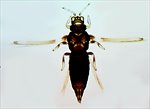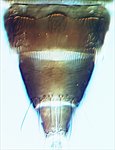Generic diagnosis
Female macropterous. Head wider than long, strongly reticulate, not projecting in front of eyes; ocellar region elevated, occipital ridge present; two pairs of postocular setae; maxillary palps 2-segmented. Antennae 8-segmented, segment I without paired dorso-apical setae; III with sense cone forked, IV with one forked and one simple sense cone. Pronotum strongly reticulate, no long seta. Mesonotum entire, reticulate, anteromedian campaniform sensilla absent. Metanotum strongly reticulate with triangle, median setae behind anterior margin, campaniform sensilla present. Fore wing anterior margin fringe cilia longer than costa setae; first vein setal row with wide gap, with two distal setae; second vein setae widely spaced; clavus with four veinal but no discal setae; posteromarginal fringe cilia wavy. Prosternal ferna divided; basantra membranous and without setae; mesosternal endofurca without spinula, metasternal endofurca U-shaped not reaching mesothorax. Legs strongly reticulate, tarsi 1-segmented. Tergites without ctenidia, with entire craspedum; tergite II without special sculpture; II–VIII reticulate except for paired posterior submedian smooth areas; VIII with comb laterally or complete; IX with two pairs of campaniform sensilla; X median split complete. Sternites covered with longitudinal reticulation, craspedum entire; II–VII with three pairs of posteromarginal setae; VII with two additional setae, either small or equal to median setae.
Male sternites VII–VIII or VI–VIII with small circular pore plate or without pore plates.
Biological data
The species of Helionothrips feed and breed on leaves.
Distribution data
This is a palaeotropical genus that is widely recorded in southern China.
Nomenclatural data
Helionothrips Bagnall, 1932: 506. Type species Heliothrips brunneipennis Bagnall 1915, by monotypy.
The genus includes 28 species (ThripsWiki, 2020), of which the following 12 are recorded from China:
aino (Ishida, 1931: 34). (Heliothrips)
annosus Wang, 1993: 391.
brunneipennis (Bagnall, 1915: 318). (Heliothrips)
cephalicus Hood, 1954: 191.
communis Wang, 1993: 392.
errans (Williams, 1916: 243). (Heliothrips)
linderae Kudo, 1992: 279.
lushanensis Wang & Tong, 2017: 48
mube Kudo, 1992: 275.
parvus Bhatti, 1968: 36.
ponkikiri Kudo, 1992: 284.
rugatus Mirab-balou & Tong, 2016: 151.
shennongjiaensis Feng, Yang & Zhang, 2007: 454.
unitatus Chen, 1981: 121.
Relationship data
Thripidae sub-family Panchaetothripinae: this group is represented widely around the world, particularly in tropical areas, and comprises about 40 genera. Helionothrips is probably related to Hercinothrips (Mound et al., 2001), an Afro-tropical genus that includes two widely distributed pest species that apparently are not yet recorded from China. The species of Helionothrips are remarkable for the arch-like sculpture of the tergal antecostal ridges, and the pronounced median triangular area on the metascutum.
References
Mirab-balou M, Wang ZH & Tong XL (2017) Review of the Panchaetothripinae (Thysanoptera: Thripidae) of China, with two new species descriptions. The Canadian Entomologist 149 (2): 141–158.
Mound LA, Marullo R & Trueman JWH (2001) The greenhouse thrips, Heliothrips haemorrhoidalis, and its generic relationships within the sub-family Panchaetothripinae (Thysanoptera; Thripidae). Journal of Insect Systematics and Evolution 32: 1–12.
ThripsWiki (2020) ThripsWiki - providing information on the World's thrips. <http://thrips.info/wiki/Main_Page>




